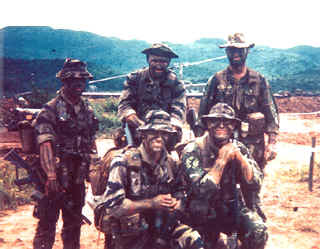|
Vietnam
War Rangers
Department of the Army for public distribution

The 75th Ranger Regiment is linked directly and
historically to the 13 Infantry Companies of the
75th that were active in Vietnam from February
1, 1969 until August 15, 1972. The longest
sustained combat history for an American Ranger
unit in more than three hundred years of U.S.
Army Ranger History.
The 75th Infantry Regiment was activated in
Okinawa during 1954 and traced its lineage to
the 475th Infantry Regiment, thence to the
5307th Composite Provisional Unit, popularly
known as Merrill's Marauders.
Historically, company I (Ranger) 75th Infantry,
1st Infantry Division and Company G, (Ranger)
75th Infantry, 23rd Infantry Division (Americal)
produced the first two U.S. Army Rangers to be
awarded the Medal of Honor as a member of and
while serving in a combat Ranger company.
Specialist Four Robert D. Law was awarded the
first Medal of Honor with I\75 while on long
range patrol in Tinh Phoc Province RVN. He was
from Texas. Staff Sergeant Robert J. Pruden was
awarded the second Medal of Honor with G\75
while on reconnaissance mission in Quang Ni
Province RVN. He was from Minnesota. In addition
to the two Medal of Honor recipients above,
Staff Sergeant Lazlo Rabel was awarded the Medal
of Honor while serving with the 74th Infantry
Detachment (LRP), a predecessor to Company N,
(Ranger) 75th Infantry, 173rd Airborne Brigade
while on a long range patrol Binh Dinh Province,
RVN. He was from Pennsylvania.
Conversion of the Long Range Patrol Companies of
the 20th, 50th, 51st, 52nd, 58th, 71st, 78th,
and 79th Infantry Detachment and Company D,
151st Infantry Long Range Patrol of the Indiana
National Guard, to Ranger Companies of the 75th
Infantry began on February 1, 1969. Only Company
D, 151st retained their unit identity and did
not become a 75th Ranger Company, however, they
did become a Ranger Company and continued the
mission in Vietnam. Companies C, D, E, F, G, H,
I, K, L, M, N, O and P (Ranger) 75th Infantry
conducted Ranger missions for three years and
seven months every day of the year while in
Vietnam.

Like the original unit from whence their lineage
as Neo Marauders was drawn, 75th Rangers came
from Infantry, Artillery, Engineers, Signal,
Medical, Military Police, Food Service,
Parachute Riggers and other Army units. They
were joined by former adversaries, the Viet Cong
and North Vietnamese Army Soldiers who became
"Kit Carson Scouts", and fought
alongside the Rangers against their former units
and comrades. Unlike Rangers of other eras in
the 20th century who trained in the United
States or in friendly nations overseas, LRP and
Rangers in Vietnam were activated, trained and
fought in the same geographical areas in
Vietnam.
Training was a combat mission for volunteers.
Volunteers were assigned, not accepted in the
various Ranger Companies, until, after a series
of patrols, the volunteer had passed the acid
test of a Ranger, Combat, and was accepted by
his peers. Following the peer acceptance, the
volunteer was allowed to wear the black beret
and wear the Red, White and Black scroll
shoulder sleeve insignia bearing his Ranger
Company identity.
All Long Range Patrol Companies and 75th Ranger
Companies were authorized Parachute pay. Modus
Operandi for patrol insertion varied, however,
the helicopter was the primary means for
insertion and exfiltration of enemy rear areas.
Other methods included foot, wheeled, tracked
vehicle, airboats, Navy Swift Boats, and stay
behind missions where the Rangers remained in
place as a larger tactical unit withdrew.

False insertions by helicopter was a means of
security from ever present enemy trail watchers.
General missions consisted of locating the enemy
bases and lines of communication. Special
missions included wiretap, prisoner snatch,
Platoon and Company size Raid Missions and Bomb
Damage Assessment (BDA) following B-52 Arc-Light
missions.
Staffed initially by graduates of the U.S. Army
Ranger School (at the outset of the war, later
by volunteers, some of whom were graduates of
the in-country Ranger School,
the Recondo School and, line company cadres),
Paratroopers, and Special Forces trained men,
the bulk of the Ranger volunteers came from the
Soldiers who had no chance to attend the
schools, but carried the fight to the enemy.
These Rangers remained with their units through
some of the most difficult patrolling actions in
Army history, and frequently fought much larger
enemy forces when compromised on their
reconnaissance missions.
Army Chief of Staff Creighton Abrams, who
observed the 75th Ranger operations in Vietnam
as Commander of all U.S. Forces there, selected
the 75th Rangers as the role model for the first
U.S. Army Ranger units formed during peacetime
in the history of the U.S. Army.
|